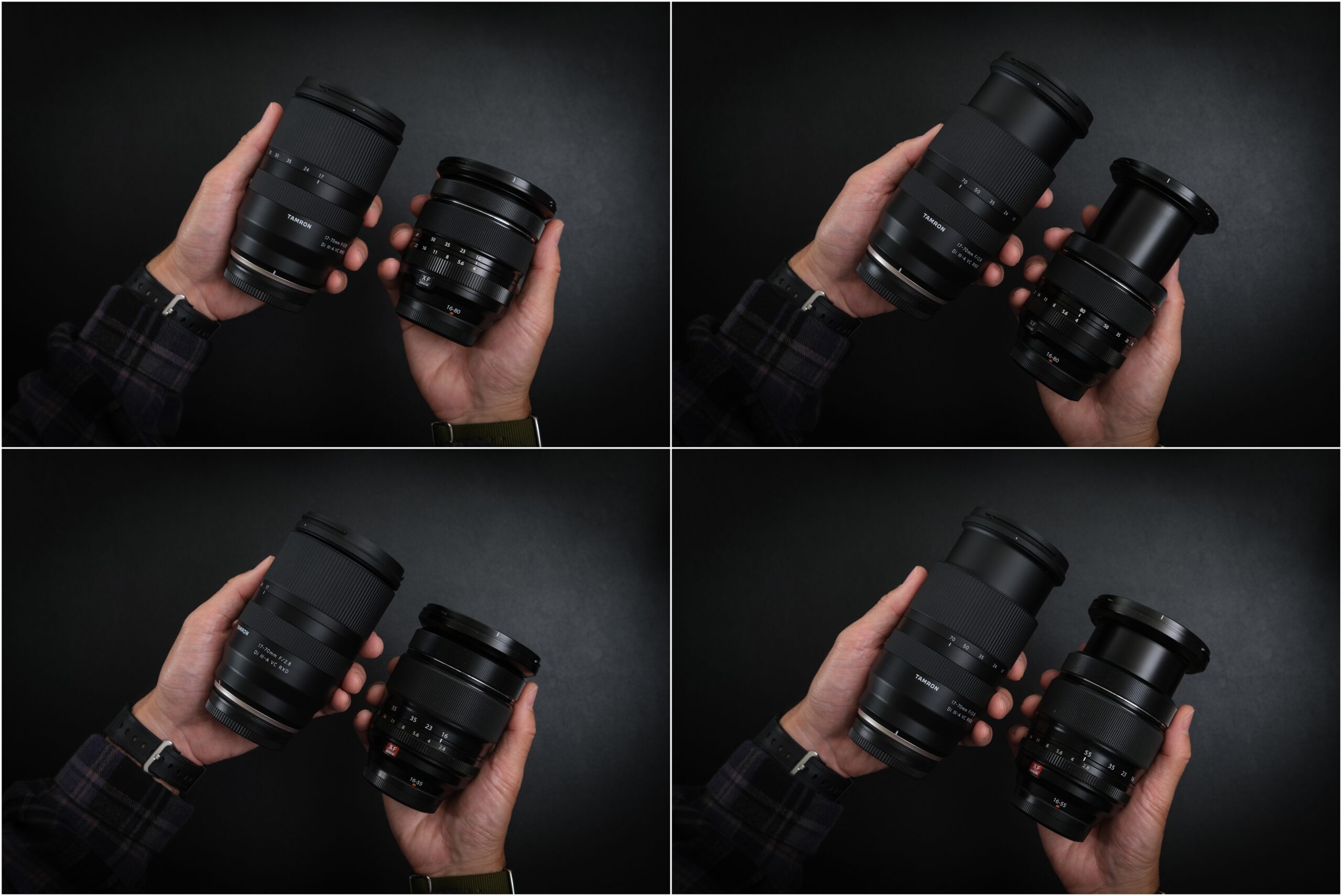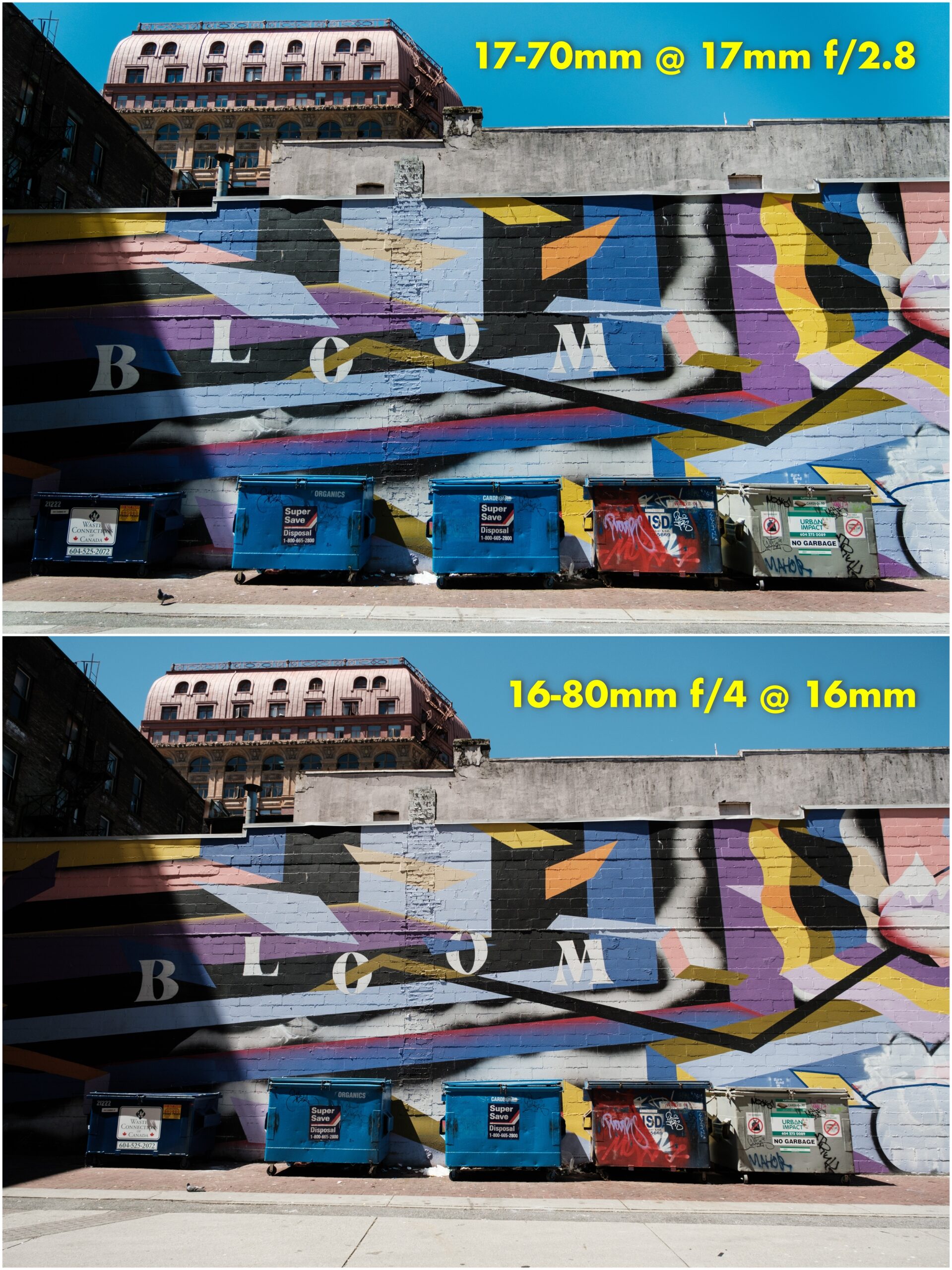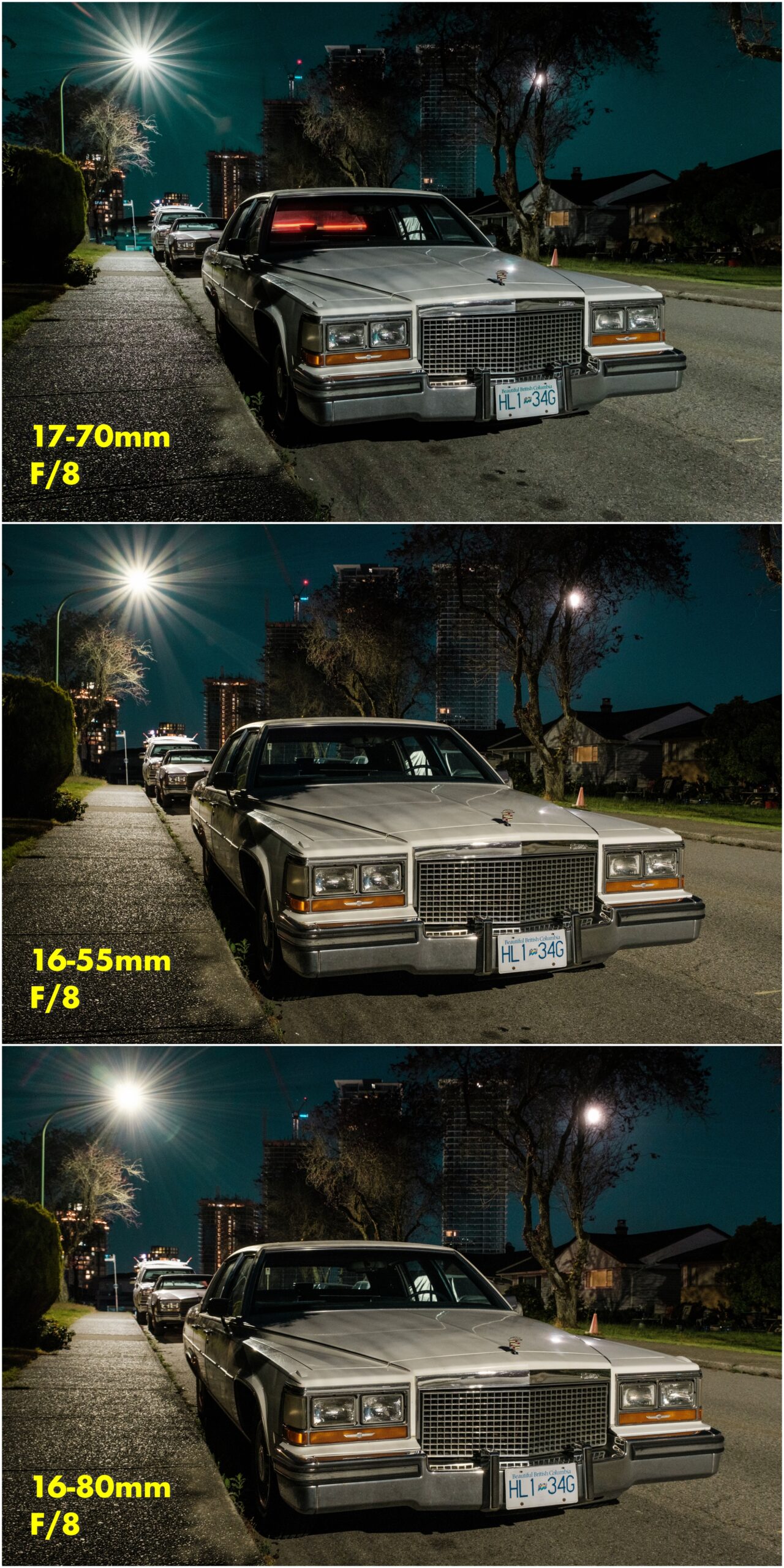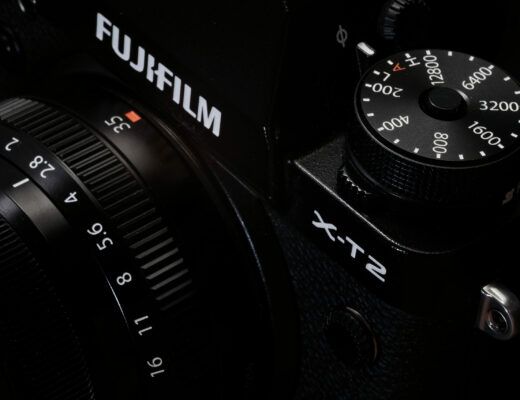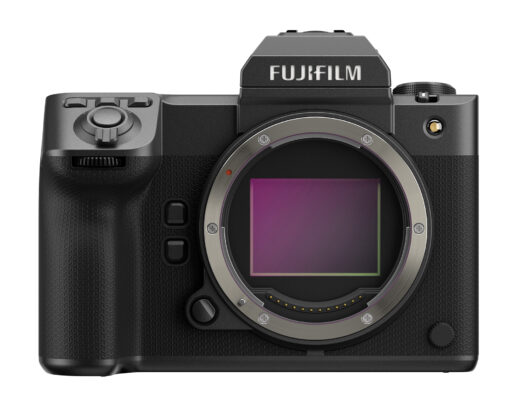Japanese lens manufacturer Tamron has been in the photographic optics industry since 1950, making them one of the oldest Japanese third-party lens manufacturers. Back in 1992, they were the first to produce an ultra-wide range AF 28-200mm zoom lens, and also had a line of professional lenses, including the SP AF 300mm f/2.8 available for Canon, Minolta and Nikon mounts. Tamron still makes unique lenses, including the 17-70mm f2.8 Di III-A VC RXD now available for Fujifilm X Mount. This is the first mid-range 4.1x zoom lens with a fast f/2.8 constant aperture for the APS-C format. Fujifilm’s red label XF16-55mmF2.8 R WR only has a 3.4x zoom range, while the 5x zoom range XF16-80mmF4 R OIS WR only has a maximum aperture of f/4. I had a chance to review the Tamron and compare it against Fujifilm’s own mid-range zoom lenses. Let’s start with the specifications.
Tamron 17-70mm F/2.8 Di III-A VC RXD
- 25.5-105mm equivalent range
- 16 elements in 12 groups, including 3 aspherical and 2 LD elements
- rounded nine-blade diaphragm f/2.8-16 with no aperture ring on lens
- 525g with 67mm filter thread 74.6 x 119.3 mm (146.5 mm with zoom extended)
- minimum focus distance of 19mm at 17mm, 39mm at 70mm
- RXD (Rapid eXtra-silent stepping Drive) = stepping motor autofocus
- VC (Vibration Compensation) image stabilization
- moisture-resistant construction along with a fluorine-coated front element to protect against fingerprints and smudging
- $799 USD list price
For those who are not familiar with how Tamron names its lenses, let’s start with the acronyms and abbreviations. ‘Di’ is a ‘Digitally Integrated’ III lens designed specifically for compact mirrorless interchangeable-lens cameras. There is no explanation for the ‘A’ except it only appears on their latest APS-C lenses. ‘VC’ is ‘Vibration Compensation’ or Optical Image Stabilization, and ‘RXD’ is ‘Rapid eXtra-silent stepping Drive’ or their autofocus system. The build quality of the Tamron is somewhere in-between Fujifilm’s XC and XF lenses. It uses mostly plastic on the exterior of the lens (except for the mount), but it doesn’t feel overly light or cheap like the XC lenses. However, when compared against the XF16-80mmF4 R OIS WR, the Tamron feels cheaper. The metal focus and aperture ring on the Fujifilm make it feel more premium, as does the heft for its compact size in comparison to the Tamron. However, the lens hood, lens cap and rear cap are made of similar thickness and weight as Fujifilm’s.
Continuing on with the build quality, the lens is considered moisture-resistant, but there’s no mention of extreme heat, cold, or dust resistance. There is a rubber seal along the edge of the metal lens mount, so I’m confident the lens can handle rain and humidity, but they are not willing to advertise the lens as weather-sealed. The front element has a fluorine coating, protecting it against fingerprints and smudging. The RXD autofocus system is as quiet and quick as Fujifilm’s stepping motor in the XF16-80mm lens, but the optical image stabilization isn’t as good. Although it’s not rated, my guess is Tamron’s VC stabilization is around 3-4 stops, versus 6 stops on Fujifilm’s XF16-80mm. The position of the zoom ring and focus ring on the Tamron is the opposite from Fujifilm, with the larger zoom ring at the very front of the lens and the narrower focus ring along the mid-back. I kept accidentally grabbing the focus ring instead of the zoom ring, although I’m sure it’s something you get used to. Finally, the missing aperture ring is probably the biggest con for most classic Fujifilm photographers.
My shooting experience with the Tamron 17-70mm f/2.8 was excellent. Although the “Beer Can” shape of the Tamron lens (reminds me of the new XF18-120mmF4 LM PZ WR) isn’t great as a compact street lens, it’s light enough to carry around all day without much discomfort. I do prefer the size and weight of the XF16-80mm, as it collapses to a compact size at 16mm, and is slightly shorter even at 80mm in comparison to the Tamron. However, in comparison to the XF16-55mmF2.8, the Tamron 17-70mm f/2.8 is more manageable as an all-day carry lens. Because the lens sticks out even at 17mm, this was a difficult lens to use discretely for street photography. I think this lens is more suited for travel, event, and videography. Although I have yet to test this lens for video, having the constant f/2.8 aperture, quick and quiet focus, quick access to the focus ring, and very little focus breathing, would be a great option for videographers. This lens is not a parfocal design, so beware of the speed of your zooming, as the autofocus can easily lose focus of your subject.
The image quality on the 17-70mm is excellent from f/2.8 to f/16. I did critical lens tests between the Tamron 17-70mm, XF16-55mmF2.8 R WR, and XF16-80mmF4 R OIS WR. Optically it is the most balanced in comparison with the other Fujifilm lenses. Edge-to-edge sharpness is consistent even at f/2.8, with optimal sharpness at f/5.6. The XF16-80mm is sharp in the middle starting at f/4, but is not sharp along the edges until f/8. The XF16-55mmF2.8 is consistently sharp at all focal lengths and all apertures, with the strongest performance at f/5.6. In terms of distortion, the Tamron exhibited noticeable barrel distortion at 17mm and pin-cushioning at 70mm, while both Fujifilm lenses handled distortion very well. Both the Tamron 17-70mm and XF16-80mm at similar issues with chromatic aberration, but was minimal and only under harsh lighting situations. This can easily be corrected in post-processing. Finally, the Tamron has amazing starbursts when stopped down, starting at f/5.6. The XF16-55mmF2.8 has decent starbursts as well, but not as clear as the Tamron. However, the XF16-55mmF2.8 handled internal flare much better than the Tamron. My guess is Fujifilm’s superior lens coatings.
As mentioned earlier, Tamron’s RXD focus system was quiet and quick, on par with the XF16-80mm lens. The older design of the XF16-55mmF2.8 was slightly slower and noisier than the other two lenses. The 19cm minimum focus distance on the Tamron is insanely close, compared to the 30cm on the XF16-55mm and 35cm on the XF16-80mm. In addition, it’s 19cm to the mount, so the subject is actually a few centimetres from the front of the lens! If you need macro-style wide-angle pictures, the Tamron is a great lens. In fact, I would recommend the 17-70mm as a great studio lens as well. I have been using the XF16-80mm as my studio, product photography, and YouTube talking head and overhead lens for the past two years. The Tamron 17-70mm can easily replace the XF16-80mm for my current needs.
Since the Tamron does not have an aperture ring, I had to re-configure both my X-T4 and X-Pro3 to use the front dial to control the aperture. By default, if you attach the Tamron to your Fujifilm body the camera automatically goes into Program mode. To force the camera into aperture priority mode with the front dial as the aperture control go to Set-Up Menu > button/Dial Setting > Aperture Setting > Manual. Another issue is the VC or OIS on the Tamron. Since there’s no switch on the lens to turn it on or off, it’s hard to tell what the camera is doing. In the X-T4, since it also has IBIS, there’s no way to activate just the OIS or just IBIS. The only way to test the OIS on the Tamron was to attach it to the X-Pro3 and turn on stabilization. As previously mentioned, the stabilization is decent for stills, around 3-4 stops, compared to 6 stops on the XF16-80mm. Finally, I wish the focus ring was reconfigurable as an aperture ring. The position of the focus ring is perfect for aperture control.
My final thoughts on the Tamron 17-70mm f/2.8 lens is that it’s a great bargain for Fujifilm X Mount shooters. At $799 USD, it’s the same price as the XF16-80mmF4. You get very similar autofocus performance, has much closer minimum focus, and is one stop brighter and sharper across the field with the Tamron. However, build quality on the Fujifilm is higher, has a metal focus and aperture ring, more compact design, true weather-sealing, less optical distortion, and the confidence of knowing the lens will always be compatible with all previous and future bodies and firmware updates. It’s hard to compare the Tamron to the XF16-55mmF2.8 R WR lens. For professional use, I would still recommend the XF16-55mmF2.8 R WR lens for its rugged build quality and WR design. Optically the XF16-55mmF2.8 is better than the Tamron but not by much. As for the 17-70mm f/2.8, you get more range, OIS, and closer minimum focus distance. Moreover, for professionals, reliability and build quality should be a priority over specs or features.
In conclusion, who is this lens for? If you really need the f/2.8 constant aperture and built-in image stabilization, there is no other option within Fujifilm’s ecosystem. This lens would be ideal as a one-lens-kit for travel, event or hybrid video-stills work. For myself, the Tamron would be a perfect replacement for the XF16-80mmF4 R OIS WR as I only use it indoors for product photography and video work. In addition, having that extra stop of speed plus the amazing starbursts when stopped down, I could use the Tamron for my low-light night photography work, which is something I didn’t do with the XF16-80mmF4. The 17-70mm f/2.8 was released last year for Sony E-mount, and Tamron finally decided to release it in X Mount this June. There is also the Tamron 18-300mm f/3.5-6.3 Di III-A VC VXD available for X Mount for $699 USD. There is one more lens I’m looking forward to, the Tamron 11-20mm f/2.8 Di III-A RXD, currently only available for Sony E-mount, but my guess is that it will eventually be released in Fujifilm X Mount. Having more third-party lens options for the X Mount is great for all of us and I’m thrilled Tamron has given us the 17-70mm f/2.8 as a great mid-range zoom option for Fujifilm X Mount users. Thanks for reading and happy shooting!





